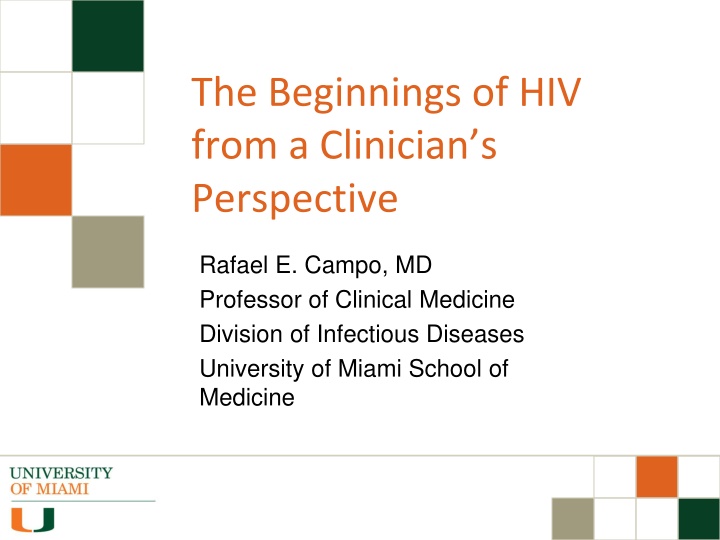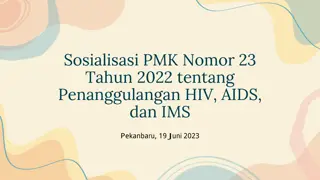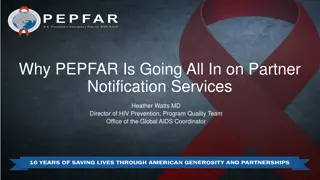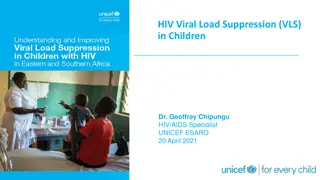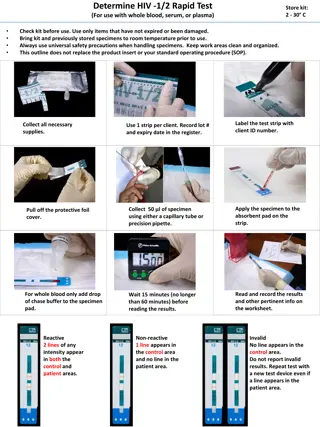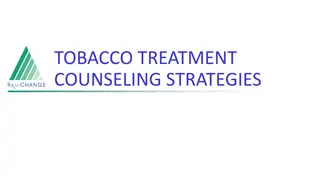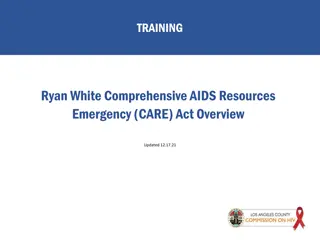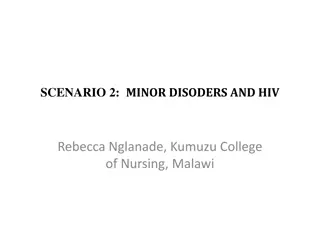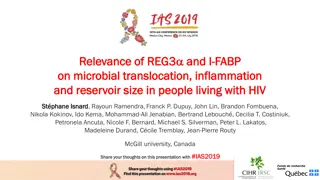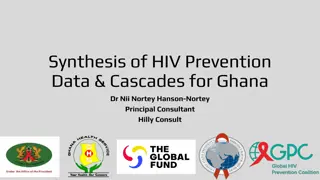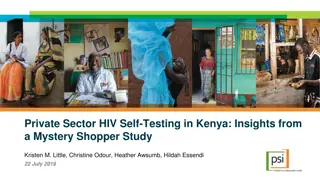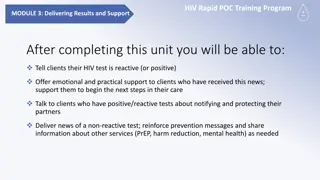The Beginnings of HIV: A Clinician's Perspective
In the early years of 1981-1985, observations and insights into the emergence of HIV/AIDS shed light on the characteristic clinical and immunologic features, affecting various populations beyond gay men. The identification of new populations, controversies, and advancements in testing marked significant milestones in understanding and addressing the HIV epidemic.
Uploaded on Mar 08, 2025 | 1 Views
Download Presentation

Please find below an Image/Link to download the presentation.
The content on the website is provided AS IS for your information and personal use only. It may not be sold, licensed, or shared on other websites without obtaining consent from the author.If you encounter any issues during the download, it is possible that the publisher has removed the file from their server.
You are allowed to download the files provided on this website for personal or commercial use, subject to the condition that they are used lawfully. All files are the property of their respective owners.
The content on the website is provided AS IS for your information and personal use only. It may not be sold, licensed, or shared on other websites without obtaining consent from the author.
E N D
Presentation Transcript
The Beginnings of HIV from a Clinician s Perspective Rafael E. Campo, MD Professor of Clinical Medicine Division of Infectious Diseases University of Miami School of Medicine
The Early Years: 1981-1985 Observations from The Coming Plague Different locations, different epidemiologic features: Newark, NYC, San Francisco, Tanzania and other cities in Africa, Miami Certain at-risk populations rapidly identified (gay men [GRID], IVD users
The Early Years: 1981-1985 Characteristic clinical picture: extremely ill young men with unusual infections and rare cancers Characteristic immunologic picture: intact capacity to produce antibodies but tremendously impaired cellular immunity
The Early Years: 1981-1985 First report published on June 5, 1981, in the MMWR was an insightful observation of what the future had in store: pneumocystis and candidiasis previously healthy individuals underlying immunodeficiency homosexuals sexual contact cellular immune dysfunction predisposition to opportunistic infections
The Early Years: 1981-1985 Disease started affecting populations other than gay men: hemophiliacs, children Newly affected populations galvanized support because it wasn t only a gay disease
The Early Years: 1981-1985 New populations identified: Haitians, women (heterosexual transmission???!!!) New continents affected with variations in the clinical picture: Europe, Africa Fear started: who was at risk?
The Early Years: 1981-1985 Scientific (and financial) controversy arose: France (1983): LAV by F. Barre-Sinoussi and L. Montagnier United States (1984): HTLV-III by R. Gallo Nobel Prize in Medicine and Physiology in 2008 to
The Early Years: 1981-1985 By 1985: first HIV test available (ELISA and Western Blot) blood supply became safer First personal observations
The Really Bad Years: 1986- 1996 Uncertainty as to what was going on in Africa (slim disease vs. AIDS) and among heterosexuals New name: HIV First AZT trial in 1986 Miami perspective Fischl MA et al. "The efficacy of azidothymidine (AZT) in the treatment of patients with AIDS and AIDS-related complex". The New England Journal of Medicine. 1987. 317(4):185- 191.
The Really Bad Years: 1986- 1996 Personal perspective: 1988 (residency) New drug (ddI): 1989 Ryan White act passed: 1990 Personal perspective: 1991 (fellowship, Freddy Mercury, Magic Johnson) The futility of care: 1993-1995 (early years of practice) Monotherapy Dual therapy
The Turning Point: 1996-2005 Personal perspective: Indinavir 035 Triple therapy Protease inhibitor-based Non-nucleoside inhibitor-based The consequences of success: side effects Lipodystrophy Allergic reactions Neuropathy
The Turning Point: 1996-2005 Other successes Improvements in survival and morbidity Post-exposure prophylaxis Prevention of mother-to-child transmission Origins of HIV PEPFAR Other failures Antiretrovirals in Africa Vaccine failures
New AIDS Cases and AIDS-Related Deaths in the United States A 20-year-old HIV-positive person is expected to live into their early 70s Life expectancy increased from 36.1 to 51.4 years from 2000-2002 to 2006-2007 70000 60000 50000 Number of Cases 40000 New AIDS Cases 30000 20000 10000 AIDS-Related Deaths 0 9596 9798 99 00010203 040506 07 08 09 10 11 12 Year CDC. HIV Surveillance Report, 2012. http://www.cdc.gov/hiv/library/reports/surveillance/. Published November 2014. Samji H, et al. PLoS One. 2013 ;8:e81355.
The Turning Point: 1996-2005 Other successes Improvements in survival and morbidity Post-exposure prophylaxis Prevention of mother-to-child transmission Origins of HIV PEPFAR Other failures Antiretrovirals in Africa Vaccine failures
The Modern Era: 2006-2015 New antiretroviral classes Entry inhibitors (e.g. CCR5 receptor blockers) Integrase inhibitors New delivery strategies Reformulation of agents (e.g. lopinavir) Single tablet regimens (the holy grail: one pill, once a day) Long-acting formulations
Transformation of ART Once-Daily, Single-Tablet Regimens No ART ZDV Mono- Therapy Sequential NRTI Monotherapy Dual NRTI Therapy Early HAART Single-Tablet Regimens With >90% Suppression Early HAART More Potent, Durable ART Earlier Initiation of Therapy New Classes of Therapy Single-Tablet Regimens Treatment Interruption Trials PrEP Fixed-Dose Combinations
The Modern Era: 2006-2015 New interventions: pre-exposure prophylaxis New challenges: hepatitis C co- infection, the treatment cascade New concepts: treatment as prevention New goals: the four-letter C word
CDC: HIV-Infected Persons Engaged in Selected Stages of the Continuum of Care (2009) CDC and Prevention National HIV Surveillance System 100 82% 80 Incidence (%) 66% 60 40 37% 33% 25% 20 0 Prescribed ART Linked to Care Viral Retained In Care Diagnosed Suppression n=1,148,200 HIV-infected persons, 18% of whom are unaware of their infection. Hall HI, et al. JAMA Intern Med, 2013;173:1337-1344.
The Modern Era: 2006-2015 New interventions: pre-exposure prophylaxis New challenges: hepatitis C co- infection, the treatment cascade New concepts: treatment as prevention New goals: the four-letter C word
The Cure for HIV: Beyond 2015 Functional vs. sterilizing cures: what is needed? Possible cure modalities Berlin patient: bone marrow transplant Co-receptor modification Early initiation of therapy: Mississippi baby Shock-and-kill strategies Therapeutic vaccination Induction of long-term latency
